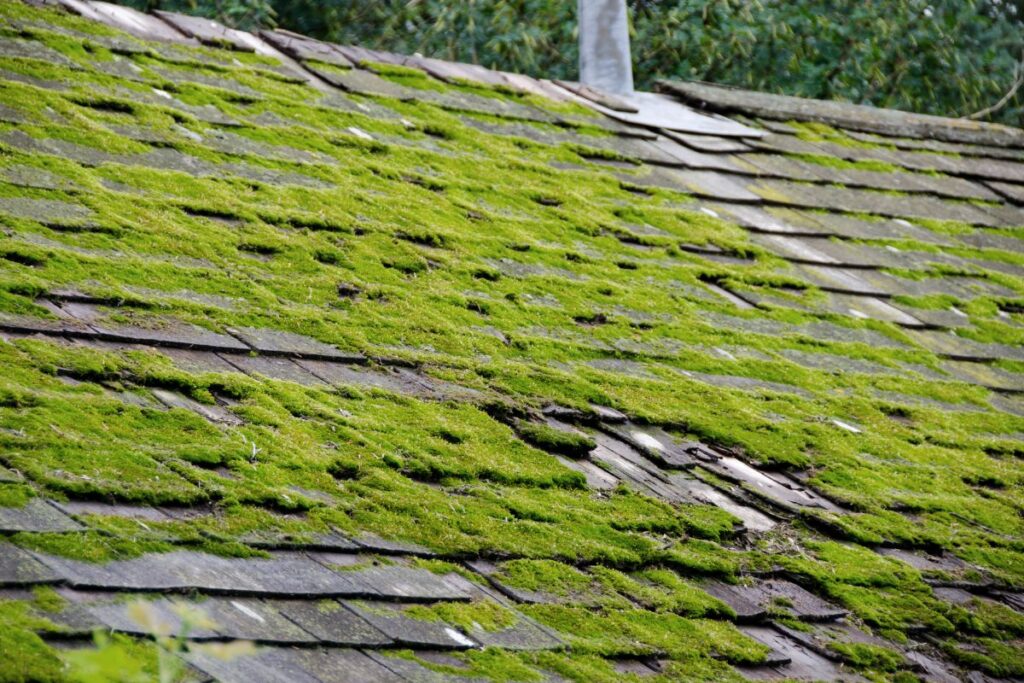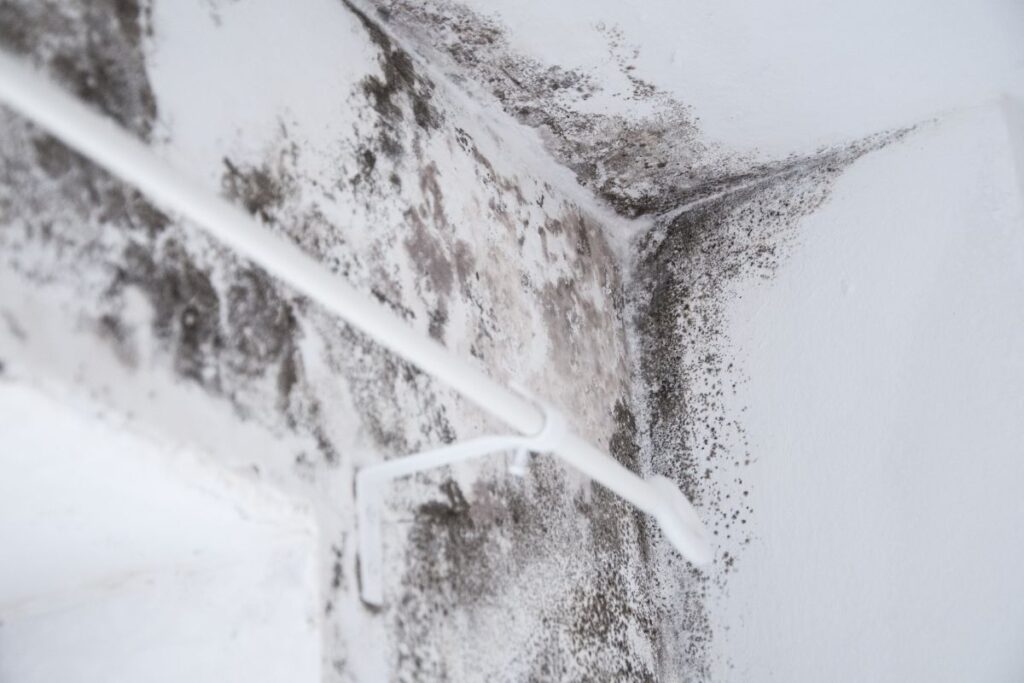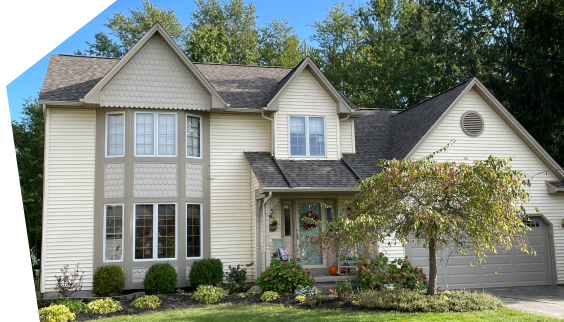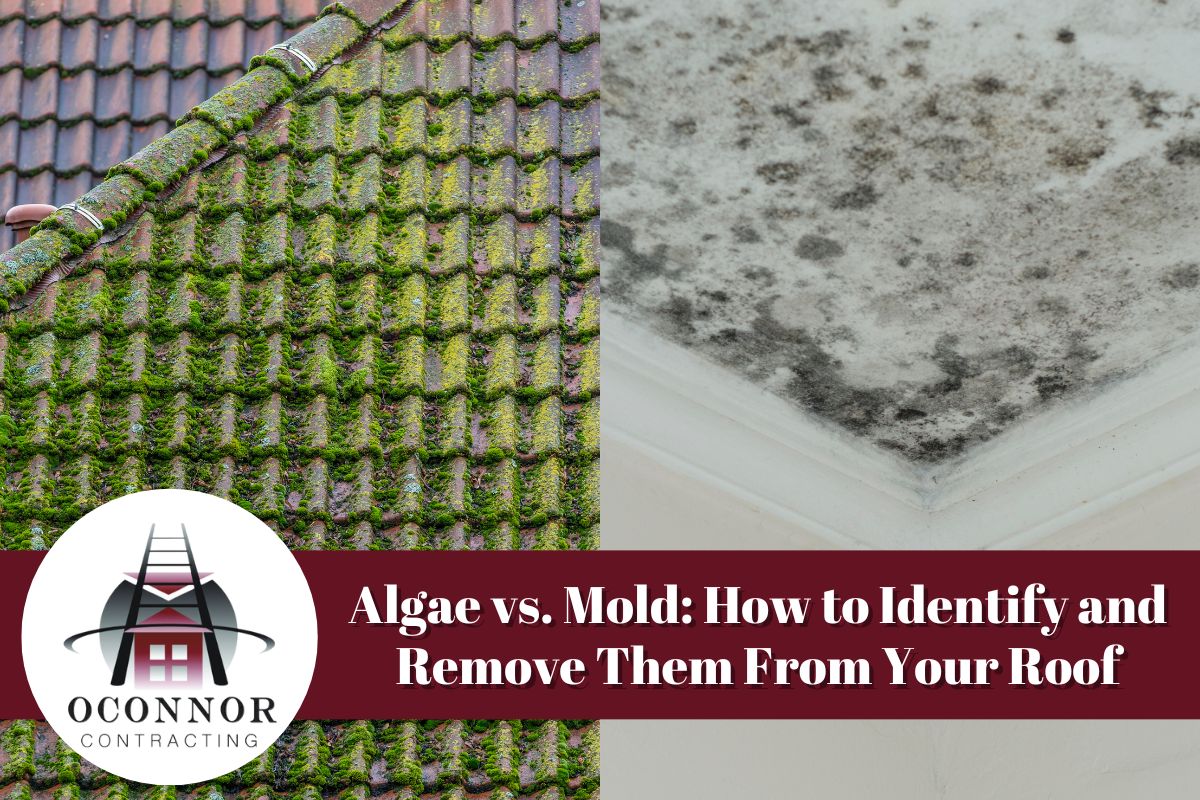You probably already know that roof stains and streaks are common in warm, humid climates, often making a home look less appealing and even affecting its durability. Though many homeowners assume these dark patches are just dirt, they are usually caused by algae or mold. While they may look similar, understanding the difference is key to proper removal and long-term prevention.
To help you out, this blog post will compare algae vs. mold so you can identify, clean, and protect your roof from future growth.
Also Read: Soft Wash vs. Pressure Wash: Which Is Safer for Your Roof? (A 2025 Guide)
What is Algae On A Roof?

A major problem that can weaken and shorten a roof’s lifespan is algae growth, which is frequently brought on by Gloeocapsa magma, commonly known as blue-green algae. It appears as black streaks, green patches, or slimy layers, thriving in humid and shaded areas. As it spreads, it traps moisture, weakening roofing materials and leading to leaks and rot.
The limestone in shingles provides nutrients, allowing algae to grow and break down protective layers on the roof. This not only causes water damage but also attracts moss and lichens, which further weaken the roof. Over time, algae can lead to discoloration, peeling paint, and stains, reducing curb appeal and posing some serious health risks for homeowners.
What Are The Causes Of Algae On The Roof?
- Airborne spores: Wind spreads algae spores, which land on roofs and start growing.
- Humid climates: Moist, coastal, and tropical areas create the perfect environment for algae to thrive.
- Shaded areas: Overhanging trees block sunlight, keeping roofs damp and encouraging algae growth.
- Limestone in shingles: Some roofing materials contain nutrients that help algae survive.
- Clogged gutters: Poor drainage causes standing water, making it easier for algae to spread.
- Porous materials: Certain roofing types absorb moisture, providing a perfect place for algae to grow.
- Poor ventilation: Trapped moisture on the roof creates damp conditions that promote algae.
What is Mold On A Roof?

Mold is a type of fungal growth that thrives in damp, shaded, and poorly ventilated areas, often appearing as green or black streaks and patches. Over time, it weakens the roof by feeding on organic materials like wood and asphalt shingles, causing them to crack and become brittle.
This deterioration increases the risk of leaks, leading to water infiltration that can spread mold inside the home. Additionally, mold shortens the lifespan of roofing materials and lowers property value by making the roof look neglected. Beyond structural damage, mold spores can enter the home through air vents, posing health risks like respiratory issues for occupants.
What Causes Mold on Roof Shingles?
- Trapped Moisture: When rainwater lingers due to poor drainage, it creates the perfect environment for mold to grow.
- Lack of Sunlight: Shaded areas from trees or buildings keep the roof damp, preventing it from drying after rain.
- Poor Ventilation: Without proper airflow in the attic, heat and humidity build up, leading to mold on shingles.
- Clogged Gutters: When gutters fill with debris, water overflows and seeps under shingles, encouraging mold growth.
- Organic Debris: Leaves, twigs, and dirt trap moisture on the roof, making it easier for mold and fungi to spread.
- Roof Leaks: Water from leaks soaks into the roof, creating damp conditions where mold thrives.
- Climate Factors: High humidity, frequent rain, and snow buildup add excess moisture, increasing the risk of mold.
- Neglected Maintenance: Without regular cleaning and inspections, mold-friendly conditions go unnoticed and worsen over time.
Also Read: Roof Spring Cleaning Checklist: Don’t Miss the Hidden Spots!
How to Identify Algae vs. Mold On A Roof?
Let’s look at how to tell the difference between algae and mold on your roof.
#1. Color
Recognizing algae on the roof is easy due to the green, blue-green, or brown streaks they leave behind. These streaks often blend into the surface but become more noticeable as black residue forms from algae feeding on limestone in shingles. In contrast, roof mold appears in a wider range of colors, including black, green, or red. It tends to be darker, more vivid, and often has a slimy texture with a musty odor. While algae primarily affect a roof’s appearance, mold’s presence may signal deeper structural damage.
#2. Growth Pattern
Spreading in thin streaks or films, algae grows flat against the roof surface, moving downward due to gravity. It thrives in moist environments with sunlight, often on the north-facing side of roofs where shade retains dampness. Unlike algae, mold on a roof forms irregular patches and penetrates deeper into roofing materials. Its growth accelerates in dark, damp spaces with organic debris, spreading rapidly when humidity levels are high. Mold vs. algae identification is important, as mold’s invasive nature makes it a bigger concern compared to algae.
#3. Texture
Feeling smooth or slimy, algae on the roof adhere closely to surfaces due to their plant-like composition. Mold on a roof, however, has a fuzzy or powdery texture, as it produces spores as part of its fungal structure. When wet, roof mold can become slimy, making it more noticeable and unpleasant to touch. The difference in texture highlights their distinct biological natures. Mold and algae behave differently, with algae being photosynthetic organisms while mold is a spore-producing fungus.
#4. Visual Cues
Identifying mold vs. algae is often simple due to the dark streaks algae create while feeding on limestone fillers in shingles. These streaks stay flat against the surface, causing only external discoloration. Moldy shingles, in contrast, appear as raised patches that can infiltrate the roof structure, sometimes leading to stains inside attics or walls. Persistent health issues among occupants may also indicate roof mold growth. Unlike algae, mold’s slimy texture and unpleasant odor serve as key warning signs.
#5. Cause
Developing from airborne spores, algae settles on surfaces with limestone filler and flourish in humid conditions with sunlight exposure. Their growth depends on photosynthesis, and they spread via wind or animals. Roof mold, on the other hand, forms in damp areas with poor ventilation and accumulated organic material. Roof leaks or trapped moisture often accelerate its development. While algae on the roof remain on the surface, mold can work its way into deeper layers, increasing the risk of structural issues.
#6. Health Risks
Affecting only the roof’s appearance, mold and algae pose different risks. Algae do not cause health issues, but moldy shingles can release airborne spores that trigger respiratory problems like asthma, throat irritation, eye discomfort, skin allergies, and nasal congestion. Prolonged exposure can worsen pre-existing conditions, making roof mold vs. algae an important distinction when considering health hazards.
#7. Risk Level
Threatening long-term roof integrity, mold can infiltrate materials, trapping moisture that accelerates rot and structural weakening. If left untreated, moldy shingles may lead to premature roof replacement. Algae on a roof, while mostly a cosmetic issue, can still contribute to gradual shingle deterioration by retaining moisture. Although algae damage is minimal, mold vs. algae identification is crucial, as mold’s ability to spread deep into the roofing system makes it significantly more destructive.
How To Prevent Mold And Algae Growth on Your Roof
Now that we know what roof mold and algae are, here are ways to stop them from growing in the first place:
1. Trim Overhanging Trees and Bushes
Branches that hang over your roof block sunlight and trap moisture, creating the perfect spot for roof mold and algae to grow. Trimming them allows more sunlight to reach your roof, keeping it dry and less prone to issues like algae and mold.
2. Prevent Water Buildup
Fix leaks, clean gutters, and repair damaged shingles to stop water from pooling. Mold and algae thrive in damp areas. Proper drainage is key to preventing roof mold and reducing the risk of algae on the roof.
3. Install Copper or Zinc Strips
When rain flows over copper or zinc strips, they release ions that prevent mold and algae growth. These strips are a long-term solution to keeping your roof free from mold and algae.
4. Choose Algae-Resistant Roofing Materials
Shingles with copper granules or moisture-resistant coatings help prevent mold and algae buildup while improving durability. Investing in these materials makes growth identification easier and reduces long-term maintenance.
5. Keep Up with Roof Maintenance
Clear leaves, twigs, and debris that trap moisture, check for damage, and schedule professional roof inspections twice a year. Regular upkeep helps prevent roof mold and algae from taking hold and keeps your roof looking clean.
6. Improve Roof Ventilation
A well-ventilated attic controls moisture levels, making it harder for mold and algae to grow. Proper airflow helps reduce the spread of mold and algae on your roof.
How To Remove Mold vs. Algae Growth From A Roof
If they’ve already taken hold, here’s how to safely clean algae and mold off your roof:
Removing Roof Mold
To get rid of roof mold, apply a bleach solution mixed with water. Use a soft brush or sponge to spread it, let it sit for 15 to 30 minutes, then rinse with clean water. For deeper cleaning, professional soft washing with mold-inhibiting detergents is effective but should be done by experts to avoid damage.
Removing Roof Algae
To remove algae on the roof, soft washing with algae-removing solutions is a good option but should be handled by professionals. A gentler option is oxygen bleach or eco-friendly products like Wet & Forget, which can be applied safely without harsh chemicals. These sprays work well and can be used from the ground or a ladder for added safety.
Not Sure If It’s Algae or Mold? Call OConnor Contracting for Identification & Repair!
If black streaks or fuzzy patches are ruining your roof’s appearance, OConnor Contracting is here to help. As a GAF Master Elite® contractor with an A+ rating from the Better Business Bureau, we specialize in expert roof repair services, effectively removing algae and mold while protecting your roof. Our team understands how these growths can damage roofing materials, so we use safe and effective techniques to restore both durability and curb appeal. Trust us to keep your roof clean and strong. Call us today at (716) 600-7663!


